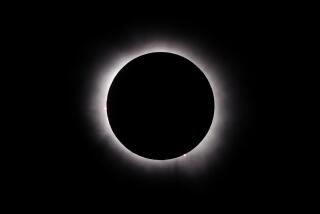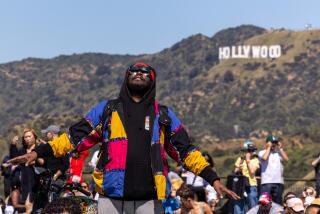Total Solar Eclipse Delivers Shades of Millennial Magic
- Share via
REIMS, France — Casting darkness across Europe in the very heart of day, the last total solar eclipse of the millennium on Wednesday brought with it wonder and hokum, celebrations and a humbling reminder that humanity is a small cog in the mechanics of existence.
Sweeping across Earth’s face at more than 1,700 mph, the 60-mile-wide shadow projected as the moon moved in front of the sun produced false and fleeting night along a path from Nova Scotia to the Bay of Bengal off eastern India.
“You realize there’s a universe out there when something like this comes along to remind you,” marveled Dennis Coombs, 53, a civil servant from London, who traveled to eastern France with his wife Brenda, 51, to see the eclipse.
In Iran, Ayatollah Ali Khamenei, the nation’s spiritual leader, called on the Muslim faithful to pray before the awesome display of God’s power. At the Vatican, Pope John Paul II, an astronomy buff, cut short his weekly audience with pilgrims, saying, “I know that some of you are in a hurry to see the eclipse of the sun.” The pontiff then viewed it himself from the papal helicopter through welder’s glasses.
In Reims, capital of France’s Champagne region, the thick cloud that kept much of northern Europe from witnessing the much-awaited celestial event parted just in time for the Coombses and 80,000 others massed on the cobblestones in front of the Gothic cathedral to see the dark orb of the moon snuffing out the sun. People cheered and applauded.
There was a final, dazzling burst of light from the sun’s lower left-hand edge--a phenomenon known as the “diamond ring.” Then, at 24 minutes past noon, an eerie twilight fell on Reims, and birds flew home to roost in the 13th century cathedral’s twin bell towers.
“Realizing what was going on above our heads--the moon moving perfectly in front of the sun--moved me deeply,” said Peter Vinde, 50, a Danish dentist who made a 13-hour overnight bus trip to see the eclipse, and had to be back at work today. “I think I was trembling all over.”
After 2 minutes and 4 seconds of darkness, the sun began to re-emerge, and Reims once again was bathed in light. To celebrate, American soprano Jessye Norman, performing on a stage specially erected in front of the cathedral, belted out the old spiritual “He’s Got the Whole World in His Hands.”
Some watchers popped the corks of Champagne bottles to toast the fact that they’d come through an event long considered an astronomical harbinger of evil.
Hundreds of miles north and south of the 60-mile strip of total eclipse, deep into northern Europe, Africa and the Middle East, the sun was partially blocked.
In Paris, where 99% of the sun was hidden, throngs packed the Champs Elysees, the observation platforms of the Eiffel Tower and other public places. As daylight waned, street lights came on and the tower was lighted.
In London, 96.5% of the sun was hidden. Telephones fell silent and trading floors emptied as employees in Europe’s most important financial center stopped work to rush outside. The London Chamber of Commerce estimated that the viewing may have cost the city $154 million. At the Old Bailey criminal court, trials were adjourned briefly so that judges and lawyers--but not defendants--could empty into the street and watch.
In Cornwall, in far western England, where well over 1 million people converged to be directly in the path of the moon’s shadow, heavy clouds hid the spectacle. In Stuttgart, Germany, an estimated half a million people who turned out were soaked by rain. Some had a glass of beer or two as a consolation.
Some Austrian cafes put a special “sun beer” on their menu. The Paris-based Novotel hotel chain was offering a special eclipse day-menu--nothing but black and yellow dishes. Hotels on Bulgaria’s Black Sea sold out. In Hungary, travel agencies chartered 13 boats to carry tourists onto the waters of Lake Balaton.
In Villeneuve-sur-Fere, France, a village of 243 people, a third of the residents were planning to dress up like Aztecs. To watch the sun disappear and reappear and hear the open-air concert that Norman gave, a special daylong excursion of the Orient Express to Reims was organized, with round-trip tickets from Paris costing as much as $1,500.
At the Swiss border city of Basel, traffic was snarled for 12 miles as people headed for observation posts in France and Germany. Motorists crowded rest stops on one German highway, nicknamed the “Eclipse Autobahn” because it followed the trajectory of the moon’s shadow.
Some of the more fortunate paid $2,400 apiece for seats on two supersonic Concorde jetliners, which took off from London’s Heathrow Airport to chase the eclipse.
A few astrologers and doomsayers, including fashion designer Paco Rabanne, had been predicting that Wednesday’s eclipse would bring natural calamities, even the end of the world. In Paris, 200 people met near one of Rabanne’s upscale boutiques to share a “survivor’s aperitif” and mock the couturier’s dire prophecy that on the very day of the eclipse, Russia’s Mir space station would fall to Earth and destroy Paris.
In fact, the space station stayed aloft, and the three cosmonauts aboard took what Russian space officials said was the first footage of a solar eclipse from space.
Viktor Afanasyev, captain of the Russian-French crew, said usually cosmonauts see only darkness when the station is passing over the nighttime half of Earth.
“Most of the time, when we move into shadow, it covers a large area,” he said. “This is the first time it looks like a distinct spot.”
In Cornwall, white-robed Druids and pagans marked the conjunction of the sun and moon with celebrations harking back to the ancient Celtic rites. According to Steve Fletcher, a reporter for a local newspaper, one ritual, at the prehistoric stone circle of Boscawen-un, was attended by 200 witches, pagans and members of the “Donga tribe,” who live ecologically friendly, unmechanized lives in homes made of willow branches. In Israel, most took the eclipse in stride, with commerce and traffic continuing throughout the afternoon.
But in nearby Palestinian-ruled areas, streets were all but deserted as most heeded Palestinian Authority warnings to stay inside, behind covered windows, if possible. The self-rule authority, headed by Yasser Arafat, declared a public holiday and put hospitals and medical services on emergency alert, following the cautious lead of much of the Arab world.
In Ramallah in the West Bank, Ayman Zeitawi lingered with a handful of friends in the city’s normally bustling central square.
“Everyone’s afraid,” said Zeitawi, a 21-year-old law student. “They’re scared they’ll hurt their eyes, but I think it’s an adventure. I don’t want to miss it.”
The World Health Organization recommended that watchers use special glasses that would cut the sun’s brilliance by at least a thousand-fold. Despite weeks of warnings from public health officials, by midafternoon Wednesday, London’s Moorfield Eye Hospital had received more than 100 calls for post-eclipse eye treatment.
Associated Press reported that a 24-year-old student who climbed a 16-foot utility pole in Landau, Germany, near the French border, to get a prime eclipse viewing position accidentally touched the electrical line and received a 20,000-volt shock. He was hospitalized with serious burns.
*
Times staff writers Maura Reynolds in Moscow and Rebecca Trounson in Jerusalem and Janet Stobart of The Times’ London Bureau contributed to this report.
Video and additional photos of the eclipse are available on The Times’ Web site at https://www.latimes.com/eclipse.
More to Read
Sign up for Essential California
The most important California stories and recommendations in your inbox every morning.
You may occasionally receive promotional content from the Los Angeles Times.













